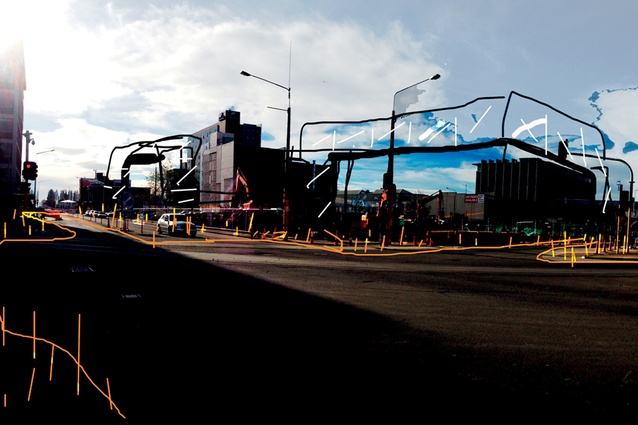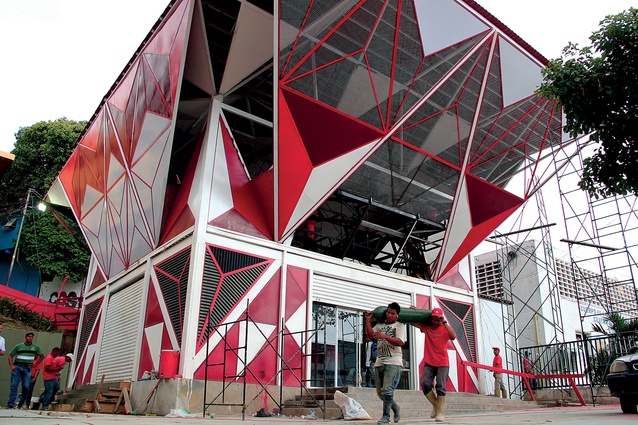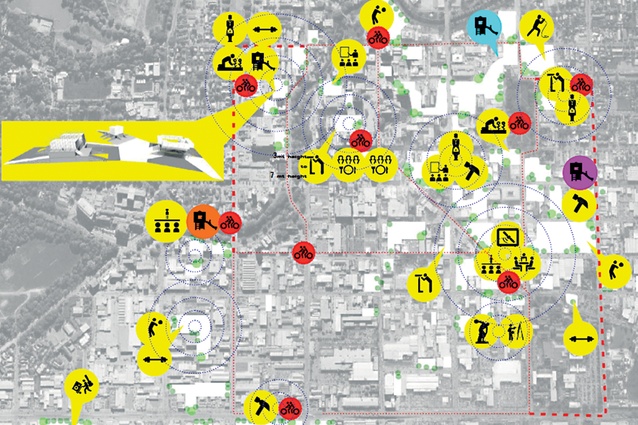Alejandro Haiek Coll: “First of all, we are citizens”
Venezuelan architect and artist Alejandro Haiek Coll has dedicated his career to resuscitating inactive landscapes, degraded social contexts and post-catastophe situations. Justine Harvey interviewed Haiek Coll, who has been a frequent visitor to New Zealand.
Described as “one of the most innovative alternative young urbanists practising today”, Alejandro Haiek Coll is the co-founder of the laboratory of design and fabrication LAB.PRO.FAB and The Public Machinery. He is also a professor at the Faculty of Architecture and Urbanism, Central University of Venezuela.
Haiek Coll’s work is focused on bottom-up initiatives that engage actively with communities to help transform their social situations and improve their built environments. Last year, he collaborated on a number of public participatory projects in Christchurch, one of which was a highlight at the Festival of Transitional Architecture. A star on the rise, in 2014, he was also Elam International Artist in Residence at The University of Auckland and he won the International Award for Public Art (IAPA) for the Tiuna el Fuerte Cultural Park project in Caracas, Venezuela.
In its manifesto, The Public Machinery tackles the idea that cities are constantly under threat “by the effects of time, meteorological and atmospheric inclemency and a rigorous social life”. It suggests that the city is a reprogrammable organism that has to updated regularly to meet the demands of its people:
“It cannot be conceived as an abstract model anymore but as an entity that brings together individual and collective concerns. The city will be progressively closest to a logistical design of a chain of events than to massive constructions. The metropolitan agenda would admit the activation for the social environment throughout collective practices and citizen participation.”
He adds: “Regardless of whether one is in Caracas or Christchurch, it is clear to me that the democratic default position is debate and confrontation. Architecture and urbanism… rarely have we developed mechanisms to enable resistance… Therefore, in the first instance, we must substitute the role of expert for that of the citizen. By doing so, we add ourselves to networks of mobilisation and convocation that are, in reality, already distancing themselves from traditional protest movements.
Yet, it is important to remember that those contemporaries who have begun to distribute themselves through a complex web of creative citizenship will constitute only a greater force than that of the state if they are capable of replicating experiences and promoting multiple forms of participation and integrative collaboration. The challenge in the future will be to take on legislations and develop new modes of collective action, as well as urban spaces for citizenry.”
Justine Harvey interviewed Haiek Coll during his recent visit to Auckland as keynote speaker at the IAPA conference.
Justine Harvey: You come from Venezuela, a country which has undergone a lot of political upheaval. In your lecture you talked about the extremes of left and right and I wonder how that informs how you think about architecture.
Alejandro Haiek Coll: One of the surprising things about Venezuela is that it has had one of the longest democracies in South America: more than 40 years of democracy. This is amazing in the context of Latin America, which has suffered from dictatorships, such as in Argentina, Brazil and Chile, for many years. In Venezuela, the last dictator was in the 1950s. And there wasn’t always a real democracy after that either but a process of instability that led all the countries of the world to extract petroleum. We just pretended to have a democracy in a country where social difference was increasing.
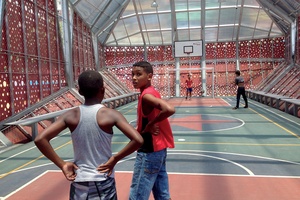
After the last dictator, Venezula received a lot of contacts with US companies that control the oil and, suddenly, something happened and democracy grows in Venezuela after this. The parties share in the power and make the Punto Fijo Pact [1958] to arrange how the country is going to run in order to balance the political forces. This started 40 years of democracy. It changed hands: the socialist and communist parties were always there, but in a very low dimension, but the social democracy and popular democracy parties interchanged power every five years for more than 40 years.
In the second period of Carlos Pérez’s [1974–79 and 1989–93] power, it was crazy in that moment because the social difference was really growing with extremes in terms of poverty, etc. So he suffered this huge protest because he privatised all the state companies – water, telephone, power – and everything was really bad for the people so, immediately, the social powers exploded.
After this, in the centre of the military, there grew a sense that things should change and Hugo Chávez [who was president from 1999 to 2013] conspired with his friends to overthrow one of the presidents, Rafael Caldera [1969–74 and 1994–99]. Everybody said, “What! A military coup in our country” and he was jailed.
I never understood why, in my family, we would have five years of nice living and five years when it wasn’t easy. All of my life was like this and especially when I was at high school and studying architecture, which was one of the lowest periods. But, during the last years of high school, I started working with my father in his civil engineering company and, since, I have worked all of my career in architectural offices.
I started working in social and environmental issues after Chávez because the books that I read allowed me to understand what was happening in the world. Suddenly, when Chávez came out of jail, he said he’s going to be a political candidate; he didn’t accept the condition of the communist and socialist parties and went out on his own.
It was a new proposal, it was really fresh and he talked about a new democracy which sounded very good for a lot of people. I didn’t like it at the beginning because it was coming from a military person, which I’d rallied against; I didn’t like the idea of forcing territories and growing military technologies, as a principle. At this election, I didn’t vote because nobody offered me something I wanted. But Chávez came in and turned out to be really accessible.
There is this amazing book called A Thousand Plateaus: Capitalism and Schizophrenia by Deleuze and Guattari (1987) which discusses French ideologies. It’s beautiful because they say that contemporary society isn’t based on a dialectic form: black/white, right/left, etc….
JH: That’s kind of divisive, isn’t it?
ACH: Yes… Chomsky defined this as the synchromatic tree, which is about the things that proceed, like roots, so Deleuze and Guattari talk about these new structures put in the context of knowledge and other ways to understand ideas. If the structure is important and is rhizomatic and we forget the dialectics, we immediately create one dialectic, again. [Deleuze and Guattari use the terms ‘rhizome’ and ‘rhizomatic’ to describe theory and research that allows for multiple, non-hierarchical entry and exit points in data representation and interpretation.]
So, the reason I’m telling you this is that I understand the politics but in a deeper way because the world is more complex than left or right.
JH: Well, it’s multidimensional.
AHC: It’s not about opposition, it’s about working together to combine our idealogies, to create new policies permanently, to confront new ideas, and to try to make agreement and treatment: not a world that is always fighting in two oppositions.
JH: Well, nothing is black and white; there are many shades in between, like good people do bad things and bad people do good things. It’s difficult to judge wholly.
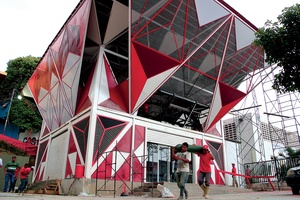
AHC: Exactly. What’s important is a new model to understand the world and that is not easy to understand; there are a lot of forces that we will never know. It’s more complex. So, looking at Venezuela, this is the reason we started doing this participatory urban re-engineering or to create new protocols or, as we call it, networking governability, which is the way things are supposed to happen: not to base all of the politics in the parties but to base the politics in the people.
Together, we should create different levels of participation to promote policies, to create solutions together and to vote together to find people who represent our interests. So often (people in power) never have the capability to do that because it’s just one person. Why do we have to have a president? Why don’t we have a complex structure that takes decisions or votes: not a heirarchy but more of a horizontal structure.
JH: I spoke with the other Alejandro – Aravena from Chile – [published in Architecture New Zealand July/August 15 issue] who touched on an idea I’m really fascinated by: this idea about ‘fear of the public’. It is that the government or even architects fear public participation – that by consulting on everything, you end up with a bland solution.
But, I think, it’s not the public’s fault. It’s about the way we organise and the platforms we create. Aravena said that consulting with the public is a “diagnosis”, not a solution in itself. It’s like going to the doctor.
AHC: Exactly. Beautiful. This isn’t a matter of just voting. This is a matter of organising together because this isn’t just a matter of ‘others’ or of politicians. Also, when constitutions change, governments talk about participatory democracy instead of representative democracy, which is beautiful. You can vote for someone to represent you or just participate in the decisions and create a new kind of democracy.
Why is this important as architects? Because we are at the centre of the programme. Because we are talking about how to recreate and reform the contemporary society. Some people say, “Oh but you just go to your office and do your plans; you’re an architect.” On my first day of working in an architect’s office, I said, “Okay, what am I going to do? I have my architect’s bag and I’m an architect now” but nobody knocked on my door. “How can I create access to the work? I have a lot of ideas to offer society that can be helpful for the people. Do I have to wait for the client?”
JH: You could wait your whole life, couldn’t you?
AHC: Yeah. Why do clients have to be the only ways to produce art or design or architecture? There are enough problems that surround us so why do we not join with these problems and put our expertise in the execution. Some people say, “The government needs to promote competitions” and competitions are good to promote a democratic way to access certain jobs. But it’s not enough because the people who create and programme competitions already have their own interests.
JH: Yes, we have examples here, like a waterfront hotel that started with commissioning a design based on consortia bids so, of course, the consortium with the most money wins. But, at this point, the hotel chain hasn’t been selected and so what are the needs of the hotel chain? There isn’t a effective brief so the design becomes redundant. Move on. This process is completely illogical. It all comes down to money and is not necessarily what is the best solution for the city, let alone the people.
AHC: It’s so illogical. Which is why I do the projects I’ve shown you. I mean, nobody knocked on my door to do this. In a way, they already exist when I arrive to a community; it’s not something I created. And this is the reason that politics is important for architecture.
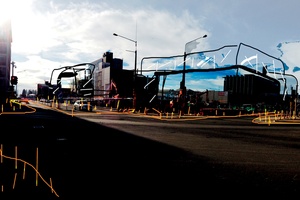
I remember this book, Lebbeus Woods: Anarchitecture: Architecture is a Political Act – Architectural Monographs (1992). It’s beautiful how Woods understood this a lifetime ago and he started to work with important things like radical reconstructions after the war in Sarajevo; he always put his hat in these things.
At the start of my lecture, I showed Baron Haussmann who worked with Napoléon III on the rebuilding of Paris because it was a way to make money. It’s kind of perverse, to destroy and rebuild. Create war, then destroy and rebuild. It’s the same with natural disasters. It becomes an opportunity to make right. In Christchurch, the insurance companies don’t pay on time for the people who left their houses and now the land prices in Christchurch are some of the most expensive. It’s ridiculous.
JH: Well you have to wonder about the politics that went on behind the scenes, especially with the demolition of so much in one great swoop; was there any public consultation? How do they know that people wouldn’t have been prepared to save some of those buildings, to wait a bit longer and spend a bit more money to save certain buildings that were important to them.
Was that question really ever asked of the citizens, I wonder? What about the history and memories contained within those buildings that are now lost or relegated to a dusty archive somewhere.
AHC: In my studio, we are remodelling a square for a 500-year-old church in Caracas and I said to the client, “Oh but this is a 500-year-old church” and the client is laughing because he says the churches in this valley are 1,000 years old. So I arrive in Christchurch and realise that it’s not even a 200-year-old city but it’s still important for the legacy, the history and memories, whether it’s 100 years or 500 years. You cannot delete or erase those memories.
The ideology is that there will be an opportunity for architects to create new buildings; it’s the same idea as the modern movement – progress and development, to understand the city just as a resource.
JH: But progress is about evolving, not just making money.
AHC: The consequences of developing everything – to develop this, develop that – is an inorganic growth. It’s important for Christchurch to create, not just infrastructure but a structure of social dynamics, and to understand how people can use the city, not just to go to work or exist but to create a communal life. It’s our responsibility now, as architects, to produce new ways to live and understand contemporary life.
Some of the people that I’ve met around the world are confronting the idea that they have to work from eight to six, then they go out and create something subversive: engage with activism. But I say, “No, you have to do what you want to do.” And they say, “But how do I make money?” This is our goal now, to find the way to live inside of contemporary society making the things that we really believe in.


